By Thomas Parker (regular contributor)
This month, I interviewed Harvard’s Janet Beizer about her new book project. It reveals a less savory slice of French culinary history hidden for almost 100 years. The subject? Leftovers.
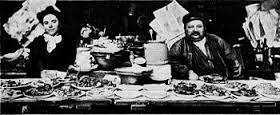
Harlequins being sold at market
Thomas Parker: I remember being in a Parisian Michelin starred restaurant many ago and how appalled the waiters were when my stepmother asked for a doggy bag. I didn’t know the French did leftovers. But that is the subject of your new book project: Harlequins. Is that an English or French term?
Janet Beizer: Well, I think I’m the first person, in all due modesty, to use it in English. It’s a French term, but it’s hard to find people in France who know what they are. There is no translation in English, except “leftovers,” which really doesn’t describe the institution. So I’ve taken the term “arlequin,” which translated literally is “harlequin,” because I think the theatrical term (the harlequin is a Commedia dell’arte character, traditionally dressed in a diamond-pattern costume) is connected to the food.
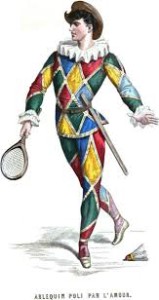
Thomas: And these were leftovers….
Janet: Exactly. Harlequins were re-plated food leftovers. They began as food from wealthy homes or mansions, townhouses (hôtels particuliers) and fine restaurants swept away in the wee hours of the morning. The butlers and the valets in the kitchen sold off the leftovers after dipping into them themselves, and maybe giving some to the dogs.
Thomas: Is this something they did on the sly?
Janet: My sense is that the owners turned their heads: the leftovers were the tip. Anyway, the lavishness was a part it all. It was so important to display your opulence, and the lavish spreads generated lots of leftovers.
Some of it was in good shape. Some of it was pretty nibbled at. It also depended on where it came from. It could come from an emperor or king’s table, depending on the era, or from a restaurant…
Thomas: So this practice went on in the 19th the 20th century?
Janet: Perhaps further into the twentieth century than we’d care to know. Definitely up until World War One. I think that there wasn’t much opulence during and after World War One…
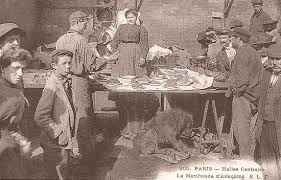
Postcard displaying a marchande d’arlequins, clients, and dog
Tom: So how did these leftovers made it to market?
Janet: The leftovers would be transported to Les Halles (Paris’ biggest fresh food market until it closed down in 1971). They would be taken underground, which is where all of the sketchy sorts of activities happened. Later on under the Second Empire it was all theoretically regulated, and there were inspectors, but… Butter was colored and mixed with artificial ingredients. Animals were cut up and the food was sometimes doctored. If you read Zola’s The Belly of Paris (1873), you learn how they stuffed the pigeons right before they were killed, infusing them with water and grain so they would be all pumped up.
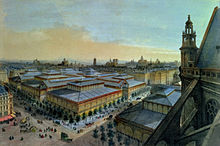
View of Les Halles from Saint-Eustache by Félix Benoist, circa 1870
Tom: Then the leftovers were sold, above in the Les Halles market?
Janet: Yes. Specialized merchants, usually women, were the marchandes d’arlequins. They would make these plates, prettifying the remains, adding herbs, loads of parsley and mayonnaise to hide the tooth marks. Today you can go into a café in Paris and order an assiette composée; I think of the harlequin plates as assiettes décomposées…
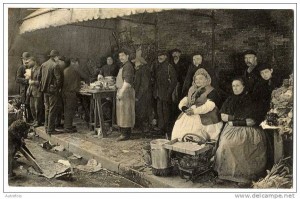
Postcard displaying market ambiance at the turn of the century
Sometimes they built them around a lobster claw, or a beef bone, and the prices would vary, depending on how much meat was on the bone. A plate with just potatoes and cabbage would go for very little.
Tom: So you would buy the whole plate, this platter with a lobster claw, and take it home. Would you admit to your family and guests where you had got the food?
Janet: It depends. There were really poor people who did this, partly because they had the fantasy of eating the emperor’s food. But there were bourgeois people as well because the plates didn’t cost any more than buying the raw ingredients for an ordinary bourgeois meal and cooking them.
Tom: So fascinating…
Janet: And, so, I think it is how French cuisine got codified, because it filtered down the whole spectrum. People learned what fancy food was by buying leftovers in the market. They got a chance to taste it or at least experience the skeletal outlines of what it was…
Tom: But I’m guessing that you wouldn’t want to be caught buying one of these platters.
Janet: Exactly. In Zola, people are described as looking around furtively to make sure they weren’t being watched…And the pretense would be that you were buying this for your pet.
Tom: Except the lobster claw… it would take a very clever dog to do the shucking.
Janet: (Laughs). But the reason it was a called a “harlequin,” was the reference to the Commedia dell’arte and the figure who wore the checkered costume. At the beginning, during the late medieval Renaissance period, the costumes were more like spots or splotches, like stains. Food stains, or moral stains. And there is a whole iconography that goes back to medieval times according to which solid colors are godly, and stains and splotches are diabolical.
Tom: Wow, so the eaters of leftovers were diabolical in some sense. Maybe that’s how leftovers got a bad name.
Janet: To go back to the Commedia dell’arte, the harlequin figure was somebody who could turn the world on its head. He started off as a valet at the beginning of the play, but might end up as a doctor or lawyer –or even the emperor– at the end.
Tom: Maybe the same rules apply to the food harlequins. You bring home this plate, you serve this plate to people, they’re impressed and you got it for cheap.
Janet: Yes, yes, or even without that, you fantasize. You eat this stuff, and you’re a god.
***
Janet Beizer is a Professor of Romances Languages and Literatures at Harvard University. Her new book in progress is entitled: The Harlequin Eaters: The Patchwork Imaginary of Nineteenth-Century Paris.
